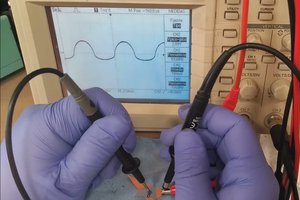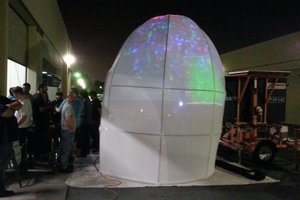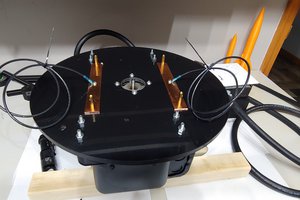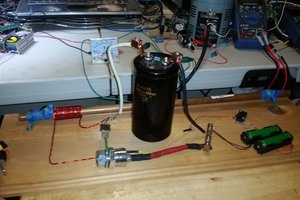This started out as a simple discussion between I, and 2 others as a means for eeking out some extra power and creating more accessible coils that aren't simply unrectified flybacks or automotive ignition packs for high voltage experiments. I would never have thought I'd gotten this far-
My friend said it would be easy and sent me a 5LBs spool of 1970s 37awg copper wire, an Arduino nano loaded with half finished code. A tiny servo all hot glued to a vinyl floorboard with 3d printed parts. When it finally arrived, it was broken so I couldn't test it or pick up where he left off So I shelved it for a few months and after frying my final and nice flyback out of an ionic air purifier and constant searching goodwill for a new one to salvage. The pandemic made everyone keep them or get bought up... so it was time to revisit.
It started with research, as always. There was not a lot of information to be found, but I did keep coming across MoReCo winders, a home winding assembly for HAM radio enthusiasts. I had to reach out to folks who had one to get close up pictures of the feed head. From there I sourced pololu drivers, 2 nema 17s and decided it would be easier to use pre-existing code to modify and a pickup winder on github seemed to fit the bill, however it required me purchase more parts.
I rebuilt that thing 3 times, added a spring tensioner and had semi acceptable results however inconsistencies and slop ended up creating issues. So armed with a good idea of the basic principle which is a set motion of left, right for the feed against the 360* divided by n turns plus a few degrees added or subtracted to create the phase shift I ended up purchasing several 2020 Aluminum extrusions, a linear rail actuator, NEMA 23s, proper drivers and revisited some of the original issues of the George Stevens machines. They had a pivoting arm, which would change the placement of the wire feed due to the axis arc as the arm raised when the coil was built. So I added a small Z axis to the rail to raise it straight up and put it on bearings so it would raise with the coil only under pressure of the weight.
I also had to purchase a proper magnetic dampening tensioner and also mounted the spool on the rail because my thought is rapid left/right motion with a static feed is going to create constant bouts of slack and consistent tension is important to create these coils.
Countless failures (they kinda worked but werent professional or cleanly wound), contacting several companies to try to source parts for the feeder head, many of them had no clue what the style was and were confused. Spellman High Voltage had to direct me to the company "historian" who informed me anyone who knew about it either has passed away, or retired. Those who did know, of other companies were super secretive. Refused to sell parts, and only would make "custom order machines" ranging from 10k to 30k
Since experimenting with various feeds later I ended up coming across a book which is impossible to find, but has a .pdf online. "Coil winding by Geo. Stevens" It confirmed everything I learned by trial and error, also gave me a little bit of new information. I also contacted the company since they were still in business. Peter was super helpful, shown me a few pics of the original machine and feeder heads, some videos of companies that use the winder that are public demos on youtube. I asked if he had any extra feeders, or knew who made them- he contacted the company that used to make them for me and the quote just for the tiny little head was $617... Back to the drawing board.
So, I attempt to revision the coding and add proper formulas to scale it because I assume this is why it keeps unravelling. Some trig x y plot math, circumference formulas Iended up with a formula I can manually adjust the arduino sketch to properly scale but it still didn't address my need for dynamic non-blocking x/y plot where the distance remains static, however the arm feeder speeds up to retain the original optimal...
Universal Coil winding Machine
A lost art, that few can still use, and guard viciously as a company secret.






 Nixie
Nixie
 T. B. Trzepacz
T. B. Trzepacz
 George Gardner
George Gardner
 3dscuba
3dscuba
Nice work, the coils look very clean! Have you looked into using a wire with a bond coat in addition to the enamel coating to enhance the mechanical strength of the coil?